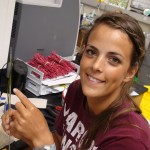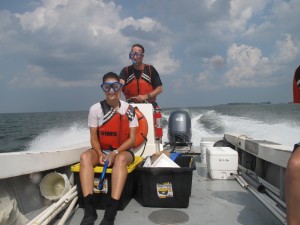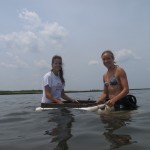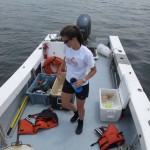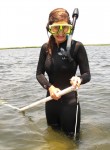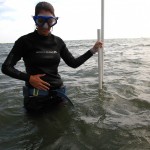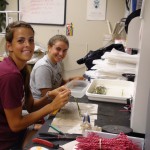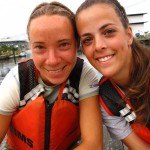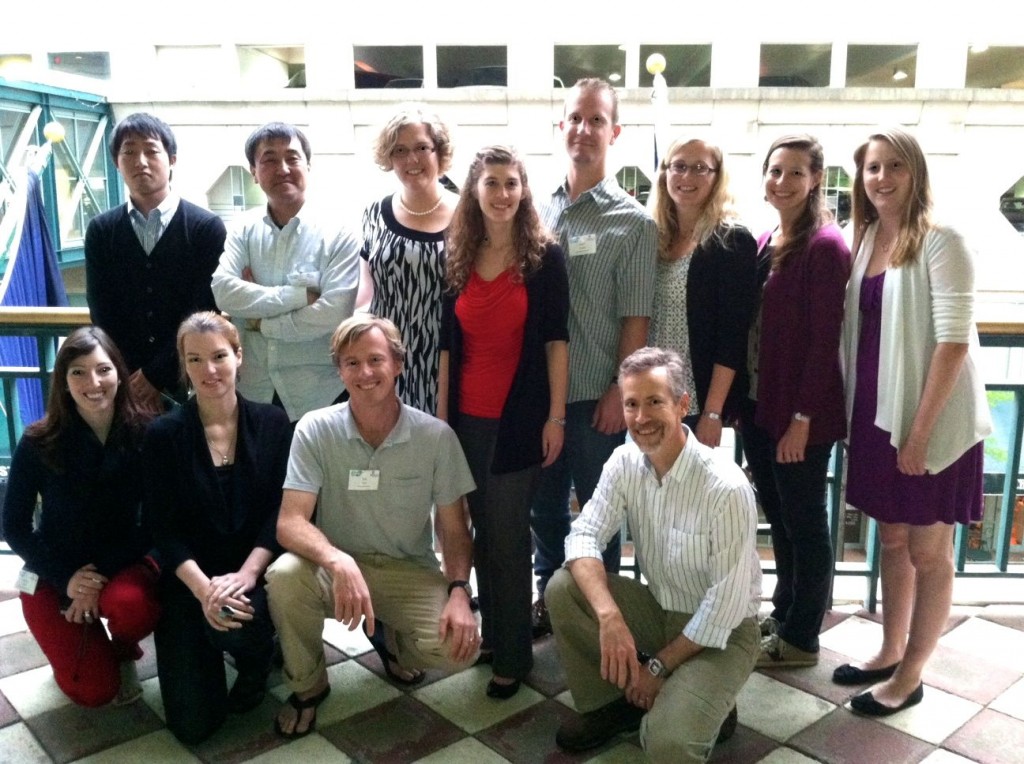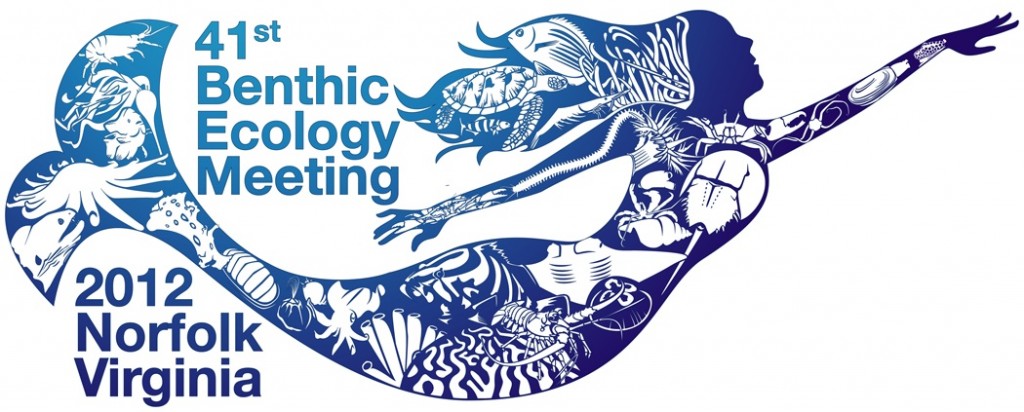Memorable moments in Virginia
by Katelyn Jenkins (College of William and Mary undergraduate student)
Many of the jobs I’ve tackled this summer have surprised me. I would not have guessed that I would become a PVC cutter, plaster block-maker, wire bender, mesh cutter, or sewer. However, I have learned that it takes a lot of skills, laughter, and water (often with a dash of Gatorade!) to prepare for such large-scale experiments in marine ecology. Through spending days of cutting many pieces of PVC and the messy job of making plaster blocks, I have enjoyed this job because of the new friends I have made in the MBL lab. From having numerous nicknames to help distinguish myself from the lab’s REU (also a Caitlin), to dancing on poles marking experimental cages in the field, this summer has been a great one to remember.
When I am not counting PVC or cutting wire, I have taken over the job of transferring seagrass samples from various ZEN partner sites to reinforced vials to grind down for nutrient (carbon and nitrogen) analysis. To do so, I have to go to William and Mary’s main campus to use a machine that will grind the samples (affectionately known as “Shakira” by its owner, Dr. Kerscher, who graciously allows us to use his lab space). The first few times I went to the main campus to grind the samples, the machine was placed in a lab. However, all of the large samples from partner sites makes for a very tired and warm ‘Shakira’. To resolve this, I planned to take breaks between sample grinding during my next visit. But, when I arrived on campus weeks later in almost 100° F weather in my shorts and t-shirt, I had no idea the machine was being moved to a cold room of 34° F! Though the initial “air conditioning” felt much needed, I quickly found myself freezing (literally) while trying to grind my samples. With multiple “defrost-Katelyn” steps inserted into the protocol (which involved running outside into the muggy Virginia heat until my fingers had thawed), I was able to successfully grind all of the samples. I can now say that I always come prepared with full gear to face the cold room. You can easily spot me walking across campus as I am the only one with a big jacket and pants in the middle of summer!
Aside from the strange climactic working conditions, I spend a lot of time in the field – one of my favorite parts! I have learned to master “Snorkeleese”, the language when talking with a snorkel in your mouth and your face down in the seagrass bed. “Ooo uoooo eeeddd elpppp?” translates easily to “Do you need help?” and “ablee eye eeese” almost always means “cable tie please”. All joking aside, most importantly I have had the chance to snorkel in the Goodwin Islands and see tons of marine life, all while learning the ins and outs of getting experiments set-up and broken-down in the field.
After taking a Marine Ecology course at William and Mary, it has been very exciting to see a lot of the things that I have read many papers on. For example, I read many papers on seagrass beds and algal blooms in the Bay and it is very interesting to see these different topics hands-on. One of the most interesting experiences I have had with marine life during the ZEN project was during the break down phase. While riding from our field site back to VIMS, about 15 dolphins began to swim around us as they searched for food. It was very exciting to see these animals so closely, especially because I have never seen so many in the York River before! Aside from this, I have had the opportunity to see tons of crabs, fish, and even sting rays!
Overall, this summer has been an incredible experience that has taught me many valuable skills. I can’t wait to see what lies ahead!
Calling all undergrads – get your hands on some science!
by Pamela Reynolds (ZEN Coordinator)
Calling all undergraduate students at the College of William and Mary, and surrounding colleges!
The Marine Biodiversity Lab at VIMS has several open positions this fall for research internships in marine ecology, evolution and biodiversity research. Students will receive hands-on research experience involving instruction in both laboratory and field techniques, as well as exposure to cutting-edge research being conducted in the Marine Biodiversity Lab at VIMS.
Research opportunities are in two areas: (1) Ecology of seagrass food webs, as part of the Zostera Experimental Network (ZEN, www.zenscience.org), and (2) Comparative ecology, evolution, and behavior of social shrimps from Caribbean coral reefs.
No experience is necessary, although we encourage applications from detail-oriented students with strong work ethic and communication skills.
Students will be instructed in the use of dissecting microscopes and other tools to identify and quantify local marine flora and fauna of the Chesapeake Bay and other estuaries (ZEN), or of Caribbean invertebrates. Students can expect to gain a strong working knowledge of the scientific process, basic taxonomy and ecological roles of marine organisms, and a greater understanding of fundamental ecological and evolutionary principles. Students will work closely with graduate students, postdoctoral researcher and staff scientists in the Marine Biodiversity Lab (http://www.vims.edu/research/units/labgroups/marine_biodiversity/index.php).
We are recruiting up to 5 students for these volunteer internship positions. Students may earn up to three course credits of MSCI 490 Research in Marine Science.
Students interested in working in this dynamic research environment should e-mail a copy of their resume and unofficial college transcript, with contact information for one WM faculty member who knows you, to both Drs. Pamela Reynolds (reynolds@vims.edu) and Emmett Duffy (jeduffy@vims.edu) to learn more about the position(s). If interested in course credit, contact us ASAP as the add deadline is fast approaching (Sept. 7th!).
The start of something new
by Katelyn Jenkins (College of William and Mary undergraduate)
My name is Katelyn Jenkins and I am a lab technician here at the Marine Biodiversity Lab at the Virginia Institute of Marine Science in Gloucester Point, Virginia. This year I will be a junior at the College of William and Mary where I am majoring in biology and minoring in marine science. As a local from Yorktown, Virginia, I have become fascinated with the environmental and economic importance of the world’s largest estuary just down the street – the Chesapeake Bay.
I became involved in research at VIMS during high school in 2008 where I worked in a Marine Conservation and Biology lab. Immediately immersed into field and laboratory work, I knew right away that marine science was a field I wanted to pursue. During 2009-2011 I began working on a research project at William and Mary that aimed to identify and characterize a harmful bacterium recently identified in striped bass in the Chesapeake Bay. Although the topic excited me, it wasn’t until I spent 2 years indoors running multiple PCR’s day after day in the lab that I knew I needed to get back into VIMS where I could study marine science on a much larger scale. In 2011, I began volunteering for Dr. Emmett Duffy in his Marine Biodiversity Lab where I learned to identify various types of seagrass, algae, and LOTS of what we affectionately call ‘bugs’ (small marine invertebrate grazers). Recently I put these new skills to the test when I returned to the lab to work as a technician for the summer.
This summer began on a busy note. I arrived at VIMS the day after I returned from a field course on the Eastern Shore. I had just enough time to unpack before I needed to repack my bags to head to Beaufort, North Carolina with our lab manager Paul Richardson to break down an experiment with the ZEN team at the University of North Carolina’s Institute of Marine Sciences (IMS). It was an exciting trip where I had the chance to meet and work with Erik Sotka and his lab group from the College of Charleston in South Carolina in addition to local NC graduate and undergraduate students. My first field experience with this lab group was an exciting one – there is a broad diversity of research projects and techniques employed in the ZEN. One of my favorite parts of the trip was having the chance to stay and work at IMS as well as learn about the ongoing research at this facility, as I have been thinking about potential graduate schools and programs to pursue after graduating from William and Mary.
After returning to VIMS, I have been involved in helping with many projects and picked up new skills: plumbing, sewing, processing chlorophyll samples, taking and sorting biomass cores, and preparing leaf tissue samples for CHN analysis. Although it may seem busy, it has forced me to become mentally organized with all of the different things going on in the lab – something that I think is a very important ‘life skill.’ I have also found that I have gained a lot of confidence in my abilities to recognize what needs to be done, when it needs to be completed by, and what needs to be done to have it completed. There’s a lot more to science than just doing research. I’ve learned that the planning, management and constant juggling of tasks is just as important as actually processing samples.
ZEN at the 2012 Benthic Ecology Meeting
The Zostera Experimental Network (ZEN) team formally emerged into public view for the first time at the Benthic Ecology Meeting this past week in Norfolk, Virginia. ZEN coordinator Dr. Pamela Reynolds (top center in the photo, in red) presented a first look at the results of our 2011 experiment evaluating the relative importance of grazing, nutrient loading, and abiotic forcing on dynamics of eelgrass (Zostera marina) communities across the Northern Hemisphere.
ZEN had representation from several of our 15 global sites, and a diverse group of PIs, grad students and undergrads, at BEM this year. These included teams from northern Japan (PI Massa Nakaoka and grad student Kyosuke Momota), Quebec (graduate students Julie Lemieux and Laetitia Joseph), Massachusetts (PI James Douglass), North Carolina (PI Erik Sotka, grad students Rachel Gittman and Nicole Kollars, technicians Danielle Abbey and Alyssa Popowich), and Virginia (Emmett Duffy, Pamela Reynolds, Paul Richardson).
The abstract of Pamela’s presentation:
A comparative-experimental approach reveals complex forcing among bottom-up and top-down processes in seagrass communities across the Northern Hemisphere
Pamela L. Reynolds (1); Emmett Duffy (1); Christoffer Boström (2); James Coyer (3); Mathieu Cusson (4); James Douglass (5); Johan Eklöf (6); Aschwin Engelen (7); Klemens Eriksson (3); Stein Fredriksen (8); Lars Gamfeldt (6); Masakazu Hori (9); Kevin Hovel (10); Katrin Iken (11); Per-Olav Moksnes (6); Masahiro Nakaoka (12); Mary O’Connor (13); Jeanine Olsen (3); Paul Richardson (1); Jennifer Ruesink (14); Erik Sotka (15); Jay Stachowicz (16); Jonas Thormar (8)
(1) Virginia Institute of Marine Science, (2) Åbo Akademi University, (3) University of Gronigen, (4) Université du Québec à Chicoutimi, (5) Northeastern University, (6) University of Gothenburg, (7) Universidade do Algarve, (8) University of Oslo, (9) Fisheries Research Agency, Japan, (10) San Diego State University, (11) University of Alaska Fairbanks, (12) Hokkaido University, (13) University of British Columbia, (14) University of Washington, (15) College of Charleston, (16) University of California Davis
Two fundamental challenges to prediction in ecology are complexity and idiosyncrasy. How do we evaluate the importance and generality of multiple, interacting factors in mediating ecological structure and processes? One promising way forward is the comparative-experimental approach, integrating standardized experiments with observational data. In summer 2011 the Zostera Experimental Network (ZEN), a collaboration among ecologists across 15 Northern Hemisphere sites, initiated parallel field experiments exploring bottom-up and top-down control in eelgrass (Zostera marina) communities. Eelgrass is among the most widespread marine plants, forming ecologically and economically important but threatened coastal habitats. We factorially added nutrients and excluded small crustaceans (mesograzers) using a degradable chemical deterrent for four weeks, and measured responses of associated plant and animal communities. As expected, results varied strongly across the global range. Our cage-free deterrent strongly reduced crustacean grazers; at several sites grazer exclusion released blooms of epiphytic algae and/or sessile invertebrates. In Chesapeake Bay, these blooms reduced eelgrass biomass after eight weeks, demonstrating mutualistic dependence between eelgrass and mesograzers. Surprisingly, nutrient addition had little effect on epiphytes, except in Massachusetts and Sweden where grazers are suppressed by mesopredators. Ongoing research is analyzing the relative influence of grazer diversity and environmental forcing in mediating these processes.
Analysis of the 2011 experiments is still under way–even as we swing into high gear for planning the 2012 experiment. We will be presenting the complete results of the 2011 experiment at the Ecological Society of America meeting in Portland (August 2012) and the 47th European Marine Biology Symposium in Arendal, Norway (September 2012). We hope to see you at one or another of these events!
This is science?
By Kara Gadeken, College of William & Mary undergraduate student
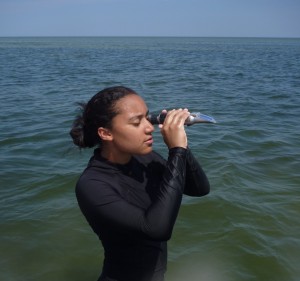
Undergraduate student Kara Gadeken takes water salinity measurements at Goodwin Islands, Virginia USA
Interning at VIMS during the hectic months when the ZEN project was at its peak was an experience that I will never forget.
The main reason that I wanted to take part in it was that, as an impassioned yet inexperienced college student, I had a reasonable knowledge base in biology but had no idea what it was like to actually do research, much less to be a part of such a grand-scale project as the ZEN. I approached Dr. Duffy at the suggestion of one of my professors at William and Mary, and luckily enough at this point his lab could use all of the help I could give.
I think the first thing that I realized while working in the Marine Biodiversity lab was that an insane amount of planning and preparation goes into research. Pamela had sticky notes and checklists and reminders all over everything in the lab, and two weeks of putting supplies together could count on one efficient day in the field. I also discovered that biologists, and especially experimental ecologists, almost have to have some engineering blood in them. In my first week at VIMS I sat in on a lab meeting to figure out how to design and construct cages to exclude predatory fish and crabs out in the seagrass beds. Time after time I heard, “How about this random thing? Hmm, I’m not sure that’ll work…How about this other random thing? Yeah, we can make something out of that!” Someone would hold up a piece of bent wire, some cable ties, bits of rope and mesh, some plastic plates. They hurled out idea after idea, trying to come up with something that could be constructed into a cage-like apparatus that would anchor into the sediment and withstand the waves. I remember stitching mesh together on an industrial sewing machine thinking, “This is science?” It didn’t take me long to realize that experiments are complicated. Not everything is perfect, and sometimes you have to work with what you’ve got, or make something new. Continue Reading

